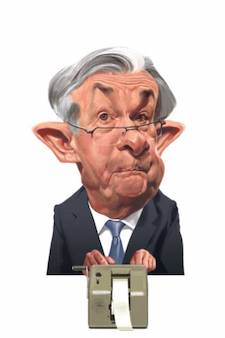 Federal Reserve Chairman Jerome Powell gave the market exactly what it wanted on Wednesday–although that might not be exactly what the economy needs. The Dow Jones Industrial Average was down about 44 points ahead of the Fed announcement; and ended the day up by 380 points, surging as Powell’s press conference reassured investors that although the Fed was pivoting toward a tighter stance, it was not going to tighten too much.
Federal Reserve Chairman Jerome Powell gave the market exactly what it wanted on Wednesday–although that might not be exactly what the economy needs. The Dow Jones Industrial Average was down about 44 points ahead of the Fed announcement; and ended the day up by 380 points, surging as Powell’s press conference reassured investors that although the Fed was pivoting toward a tighter stance, it was not going to tighten too much.
The establishment media dutifully portrayed the Fed’s announcement as revealing an “aggressive pivot” to reducing bond purchases. But beyond doubling the bond purchases, the Fed’s change of policy was anything but aggressive. Most Fed officials now expect to raise rates three times next year, up from one back in September.
That would put the target rate at 0.75 to one percent. Yet Fed officials now say Personal Consumption Expenditure (PCE) inflation will be running at 5.3 percent, up from 4.2 percent in September. In other words, the Fed saw its year-end inflation jump 1.1 points higher in just three months but raised its expectations for interest rates over the next year by just 0.75 points.
This is an indication that despite the pivot, the Fed may still be too optimistic about inflation declining more or less on its own. Fed officials think that by the end of next year, the rate of PCE inflation will have fallen to just 2.6 percent, less than half of what they expect it will be at the end of this month. That’s a very optimistic projection about the power of an average of one hike every four months to bring inflation down.
U.S. businesses are less optimistic. The Atlanta Fed’s survey of business expectations revealed this month that long-term inflation expectations moved significantly higher. Businesses now expect inflation to average 3.2 percent, the highest reading in a quarterly survey that goes back a decade. If Fed officials are right about the power of expectations to influence inflation outcomes, this should be troubling.
Perhaps the most interesting part of Jerome Powell’s press conference on Wednesday was his description of how he came to change his mind about the urgency of scaling back the Federal Reserve’s pandemic stimulus efforts. Powell told us that Fed officials had more or less decided to begin reducing bond purchases by $15 billion per month in the lead up to the Federal Open Market Committee meeting that began on November 2. A couple of days beforehand, on October 29, the Bureau of Labor Statistics released data showing a much bigger than expected jump in the Employment Compensation Index, a measure of the labor costs in the United States. That almost made Powell reconsider the size of the taper, but he held back because the $15 billion figure had already been agreed upon.
On the Friday following the Fed meeting, the jobs report showed that the economy had added more jobs than anticipated, and the unemployment rate was falling much more rapidly than expected. The following Wednesday, the Consumer Price Index (CPI) indicated a surge of inflation. These two reports sent Powell and Fed officials scurrying to let the market know that they now viewed a more hawkish stance as appropriate, setting the stage for today’s doubling of the taper to $30 billion.
It’s hard not to wonder if a similar dynamic might have played out this month. On Friday, the government released CPI data showing that inflation had soared even higher. Yesterday’s Producer Price Index was a barn burner, with prices of durable goods shooting up more than they have since 1974. Could Powell and company have once again come into the meeting beset with doubts about whether the policy agreed in advance went far enough?
We may have to wait for the December Jobs report, due out on the first Friday in January, and for further data on inflation to see if the same dynamic plays out. For those looking for a silver lining, you can take some reassurance that Fed officials were willing to change their minds and their policy when they were exposed to data that differed from what they expected. Perhaps they are slower to notice changes to the economy than we would like, but at least they are headed in the right direction.
Alex Marlow & John Carney
Breitbart News Network








